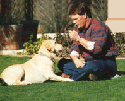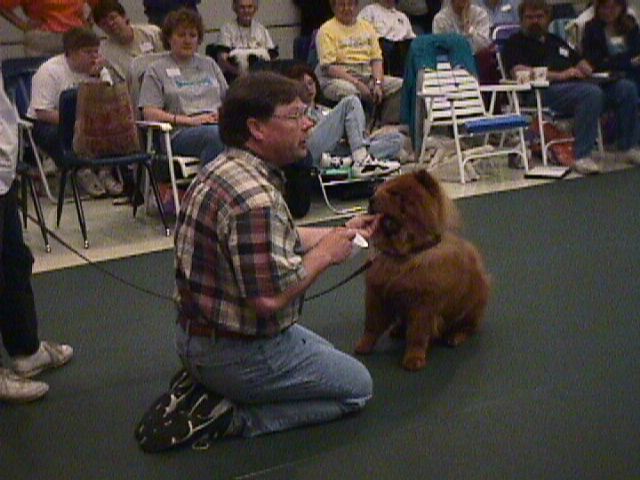 |
|||
|
|
 |
 |
|
|
 |
||
|
Finding the right trainer: Hints for non-trainers At the Barkleigh Groom Expo in Hershey, I gave a presentation on training, specifically for groomers. After it was over, one of the groomers thanked me for not assuming that she wanted to add training services to her business. She simply doesn’t want to be a trainer or behaviorist – but she wanted to know how to find a good one when her clients needed that service. That is a really good question. It’s obvious that if your client has a dog with a deal-breaker behavior, you will probably lose the client if someone can’t fix the problem. Statistically, eight out of ten dogs do not see their first birthday. The primary reason they don’t is that their owners cannot control their behavior. The reality is that some seemingly innocuous behaviors are actually lethal – eating inedible objects, jumping fences, aggression and constant barking, to name a few. If you can fix the problem or refer to someone who can, you will have a grateful client and future referrals…if not, not. If you are a pet owner, finding the right trainer can dictate whether you can keep your dog. To quote the Latin aphorism, praemonitus, praemunitus – forewarned is forearmed. There are scoundrels and incompetents aplenty in the world of dog training and behavior services – and some real master trainers. Finding the right one is an important task. Experience vs. thinking: There are three basic categories of trainers in this country – traditional, modern and professional. Traditional trainers tend to stick to methods that have proven their effectiveness in many settings for many years. Modern trainers lean toward academic sources for their information and usually reference “learning theory” and “scientific methods” when validating their style. Professional trainers offer a service that demands effectiveness such as sporting dog trainers or assistance dog trainers. These groups are very much like oil and water. Meaning they don’t mix well. When modern trainers make a reference to traditional training, they usually imply abusive, harsh treatment and archaic methods. They selectively ignore service dog trainers but denigrate sporting dog trainers based on the tools they use. Traditional trainers generally think that modern training is wimpy and undependable. That is a true statement, but they assume it without any logical basis. Perhaps it’s because modern trainers are so universally insulting toward traditional trainers. This type of instant animosity distorts the strengths and weaknesses of each philosophy and won’t automatically help you find a good trainer. Currently, these two groups are separated into three professional organizations - Association of Pet Dog Trainers (APDT) and the International Association of Canine Professionals (IACP) Each of these groups provides a test that leads to a certification. This allows their members to put letters after their names, just like board certified surgeons and registered nurses. Whether or not these certifications assure competence is questionable. A friend of mine recently passed a trainer’s certification test by answering the questions based, not on how she actually trains, but on what she thought they wanted to hear. The problem is that neither the tests themselves nor those who pass them are required to prove that their methods work or that they actually use approved methods. A fine trainer might flunk the test while a hack trainer might pass by simply spitting out phrases learned at training conferences or on the internet. Along with IACP and APDT another, older group, the National Organization of Dog Obedience Instructors (NADOI) still plugs along – mostly in the background. There is also an alphabet soup of groups who assert a connection to science and academia. They have initials like IAABC, AVSAB, ABS, and a dyslexic’s nightmare of acronyms. Most of these groups require academic credentials that would allow bored elementary school teachers to train dogs for a short time and then start adding letters after their names. No actual practical experience training dogs is necessary to belong to any of these groups. Their certifications are all based on written tests or assumptions that an academic education leads to knowledge of how to handle a dog. You can believe that or not. I’d suggest not. A serious problem is that the higher the education, the less scrutiny there is of actual competence. The certification for veterinarian behaviorists actually qualifies them to prescribe psycho-tropic drugs but does not require that they demonstrate competence handling the types of animals they will ultimately treat. While they do get some experience in vet school, after that it’s all academic “research”, speaking at conferences as experts and teaching other would-be experts what they know. If their role in solving a behavior problem is primarily drug therapy, they have extensive training in that area. (Though the drugs have not been tested in blind trials and in some cases, not tested at all for the purpose they are promoted.) If you want them to actually go in the field and train a dog not to bite strangers you may be disappointed in your choice. There is no veterinary school that teaches budding behaviorists how to stop unwanted behavior…or something as simple as teaching a dog to walk on a loose leash. Why? There isn’t any training in veterinary behaviorism in the use of aversive control. By definition, positive reinforcement cannot stop a behavior. Only some form of punishment can do that. Veterinarian behaviorists oppose the use of punishment – ergo, they oppose stopping behavior, any behavior. If you do find the odd vet behaviorist who uses aversive control, they got their knowledge from a dog trainer, not a science text book. With this rush to capture market share through “proof” of expertise, the large pet-food chains cut through the smoke and mirrors and simply created their own certifications. They put their trainers through a course of instruction and then give them a piece of paper that says they are certified trainers. “She’s certified because I say she’s certified” is a great way to side-step the issue. There are several internet based training “colleges” and “academies” that do the same thing. In your quest to find the right trainer for your clients, you will simply have to look at things other than a piece of paper. Some great trainers are not certified and some lousy trainers are. The broader point is that there really is no trustworthy certification that would help you through this maze of credentials. Traditional Trainers: The systematic training of large numbers of dogs came from the trenches of World War I. The Germans used dogs as couriers through the trenches. Between the wars, this methodology was used to create The Seeing Eye, the first successful use of dogs to help large numbers of disabled people. In WWII, the tradition of military dogs continued and expanded. At the end of the war, hundreds of military dog handlers came home and applied their new skills to a new career. They may not have been academics, but they knew how to train dogs. Over the next thirty years, the vast majority of pet dogs were trained by this standard. Contrary to current beliefs, traditional training is not inherently harsh. No method can be constantly nasty and still be effective. After the 1960’s, Americans softened their view of the world. Any method of training that included aversive control came under attack. Some of the criticism of the military style training was valid. Many dogs do not thrive under stern handling. However, the attack on tradition doesn’t focus on specific issues but simply assumes that all dogs will be traumatized if they are trained with a choke-chain. This is illogical. While some dogs at obedience competitions do hang their tails, some engage in the most rigorous competitions with tails flying. The same is true of field trials, an event that relies heavily on shock collars to create consistent performance. If shock collars are innately damaging, why do the vast majority of the dogs wag their tails while competing? Why do they greet their owners enthusiastically if they are so horribly abused? No actual evidence of harm is ever presented when these tools are attacked. For instance, contact any ten veterinarians and ask them how often they treat neck injuries from choke or prong collars. The answer will surprise you. I did that recently for an article I wrote. Of 12 vets, none of them had ever seen a dog injured by a choke or prong. Accusations about shock collars are equally illogical. While any tool can be abused, that is not an argument against their proper use. One very prominent vet behaviorist hates them because she sees many dogs at her clinic that were abused with shock collars. That is because to get to a veterinary learning college clinic the owners have tried literally everything. Correlation does not imply causality. Otherwise, the learned doctor would oppose the use of treats and positive reinforcement – something that all of the dogs she treats have been exposed to. Traditional trainers don’t get off the hook in the illogical accusations arena. There are still many trainers who refuse to use food in training because it supposedly creates a dog that is dependent on treats. Hunters have rewarded their dogs with a part of the kill for thousands of years with no ill effect on the dog’s hunting ability. To not use food treats simply wastes your clients’ time and sometimes fails to spark the interest of the dog – which leads to a program heavily weighted toward unnecessary force. The problem with this perpetual argument is that it isn’t relevant to professional training. It’s simply a spitting match between opposing ideologies. An objective analysis yields a far more flexible and dynamic approach. There are times when forceful methods are the perfect solution for head-strong dogs. There are also times when overbearing handling can ruin a sensitive dog. Sometimes the same dog needs to be wooed and coerced through a series of training sessions to get the right combination. Dogs are far too complex to be treated identically in all situations. As a groomer, kennel operator, day-care provider or pet owner, recommending the right training services does not require that you join the battle between tradition and modernity. Your job is to find the person who knows how to solve problems and provide effective, safe training for your dog or client’s dogs. If a dog loves to leave the property, you might consider getting to know the local distributor for underground containment systems. If a dog is so wired that he can’t sit still, you may have to know a good veterinarian with additional credentials to prescribe an appropriate medication. If a crusty ex-military trainer can housetrain a Yorkie, run with it. If a modern trainer claims to use exclusively positive methods but loves to use head-halters, a punishment device, your clients dogs will still be better behaved on leash – even if the trainer doesn’t know how that collar works or that using it actually breaks their commitment to “positive” training. My advice is that you use your own knowledge of dogs and then follow up on your recommendations. Keep track of who you sent where and then check back after the training is over. Stick with the people who get the results and please your clients – otherwise your clients won’t be pleased with you. Ten Questions to Ask a Prospective Trainer:
|
||
|
Copyright 1994-2013 Gary Wilkes. All rights reserved.
|
||


